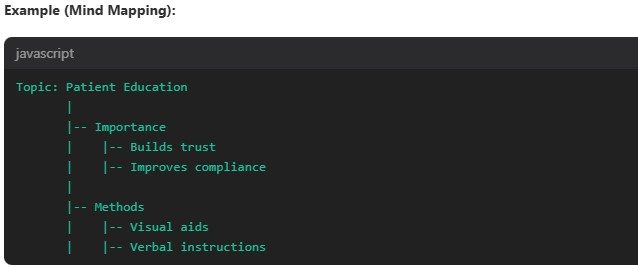5.4. Listening: Note-taking Skills
Learning Objectives
By the end of this lesson, students will be able to:
- Apply effective note-taking strategies, such as mind mapping and bullet points.
- Listen actively to a lecture or audio recording, capturing main ideas, supporting details, and key terms.
- Collaborate with peers to refine and compare notes for better understanding.
- Identify the importance of note-taking in a professional healthcare setting.
- Use two note-taking strategies: mind mapping and bullet points.
- Listen to a medical-related lecture and take organized notes.
- Summarize main ideas and supporting details from an oral presentation.
- Collaborate with a partner to compare and clarify information.
- Reflect on and apply note-taking strategies independently.
Warm-Up Discussion
Discuss the following questions in pairs or small groups:
- Why is note-taking important in professional settings, especially for CMAs?
- Have you used note-taking in the past? If so, what techniques have you found helpful?
- Write down one note-taking technique or idea shared by your partner or group:
Technique/Idea: _______________________
Part 2: Introduction to Note-Taking Strategies
Learning Note-Taking Methods
Review the following note-taking strategies:
- Mind Mapping: Use diagrams to connect concepts and visualize their relationships.
- Bullet Points: Use concise phrases to list main ideas and supporting details.
Look at the examples below and practice creating your own for a topic of your choice:
Example (Mind mapping):
 Example (Bullet Points):
Example (Bullet Points):
Topic: Patient Education
- Builds trust between CMAs and patients.
- Improves compliance with treatment plans.
- Methods:
- Visual aids (e.g., charts).
- Verbal instructions (clear and concise).
- Methods:
Practice: Choose a topic (e.g., “Time Management for CMAs”) and create either a mind map or a bullet-point list:
Part 3: Listening Activity
Taking Notes During a Lecture
Listen to the provided audio lecture. The topic will be introduced briefly by your instructor. Pay attention to:
- Main ideas.
- Supporting details.
- Examples.
Listen to the audio and use the note-taking template below to capture information using mind mapping strategy:
The lecture will be played twice. During the second listening, refine and clarify your notes.
Part 4: Pair Work for Review
Compare and Refine Notes
Pair up with a classmate and review each other’s notes. Answer the following questions:
- Did you both capture the same main ideas?
- Are there any details or examples that one of you missed?
- Highlight any key terms or concepts that are particularly important:
- Key Terms/Concepts: ____________________________________________
- Write down one idea or detail you learned from your partner’s notes:
- New Detail Learned: ____
Part 5: Write a Summary
Summarizing the Lecture
Based on your notes, write a brief summary (5–7 sentences) of the lecture. Focus on the main ideas and supporting details.
- Your Summary:
- Share your summary with your partner. Provide constructive feedback by focusing on:
- Clarity.
- Inclusion of main ideas.
- Completeness of supporting details.
- Share your summary with your partner. Provide constructive feedback by focusing on:
Part 6: Class Reflection
Reflecting on Note-Taking
Reflect on today’s lesson and answer the following questions:
- What is one new note-taking strategy you learned?
Your Answer: ____________________________________________ - How can effective note-taking help you as a CMA?
Your Answer: ____________________________________________ - Share your reflection with the class or in small groups.
Media Attributions
- mind mapping 2

